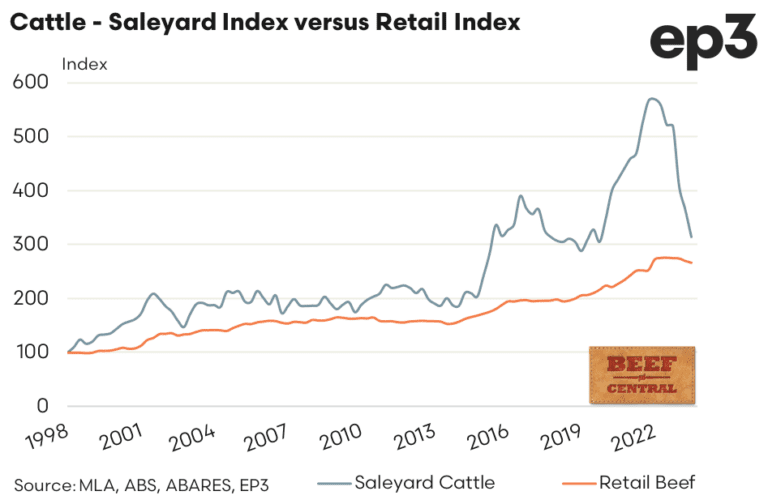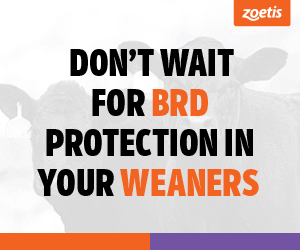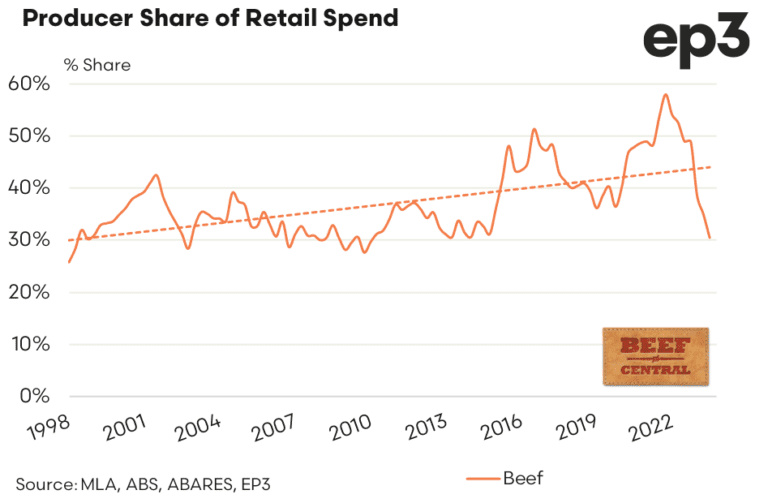
In collaboration with analysts Episode 3, Beef Central in July launched a new quarterly series looking at trends in the beef producer’s typical share of the retail consumer’s spend on beef products.
A similar analysis was compiled by Meat & Livestock Australia for four years, before being discontinued by the industry service delivery company back in December 2016. The project was originally launched during the 2012 MLA annual general meeting.
Beef Central sought, and gained MLA’s approval to resurrect the discontinued series, based on clear reader interest. The same formula is used to compile the new set of results as originally used by MLA (see explanation at base of page).
 Episode 3 and Beef Central now jointly publish a report each quarter, soon after ABS quarterly retail beef price data is released. This typically happens around late July, late October (today’s report), late January and late April. Click here to read our first report in the series, published three months ago.
Episode 3 and Beef Central now jointly publish a report each quarter, soon after ABS quarterly retail beef price data is released. This typically happens around late July, late October (today’s report), late January and late April. Click here to read our first report in the series, published three months ago.
The exercise sees national saleyard cattle prices in carcase weight terms being converted into an estimated retail weight equivalent and compared to average retail beef prices, as reported by ABS.
September quarter result
Since our last update (from the June quarter 2023) the cattle saleyard index to the end of September has dropped a further 14 percent from 365 to 314 (see graph above). Meanwhile at the retail level, the beef index has eased just 1.2pc from 269 to 266.
In terms of retail dollars per kilo average, beef prices have eased from $26.51 to $26.19 over the past three months.

Share falls to lowest level since 2010
As cattle saleyard price falls continue to outweigh retail price declines, the beef producer share of the retail spend continues to track lower too. The producer share of the retail spend on beef has dropped from 35pc in the June quarter to 30.5pc for the September 2023 quarter.
This represents the lowest the producer share of the retail spend on beef has been since the first quarter of 2010, when it dropped to 29.6pc (see graph). However, there were a few times this point was nearly breached, in Q1 2014 and Q2 2013, when the share got to 30.6pc.
About the producer share of retail calculation
The beef producer share of the retail dollar is calculated using a range of assumptions. The national saleyard trade steer indicator is used as the benchmark livestock prices, representing animals suited for the domestic market. Livestock prices are collected by MLA’s NLRS. Converting the carcase weight price to an estimated retail weight equivalent price is achieved using a retail meat yield for beef of 68.7pc.
The indicative retail meat prices are calculated by indexing forward actual average beef prices during each quarter, based on meat subgroup indices of the Consumer Price Index, provided by ABS. These indices are based on average retail prices of selected cuts (weighted by expenditure) in state capitals.
The producer share is calculated by dividing the estimated retail weight equivalent livestock price by the indicative retail price.
 Episode 3 (EP3) is an independent, data-driven market analysis service that provides premium insights and reports to the agriculture industry, food manufacturing sector and their associated markets. Through robust analytical assessment, EP3 assists agricultural stakeholders to make better, more informed decisions that drive profitability. The company is experienced in producing high-quality reports used by government, RDC’s and corporate entities. In addition, EP3 is available on a retained basis with clients to provide on-going and bespoke information to assist in their sales or purchasing process. Click here to access the Episode 3 website.
Episode 3 (EP3) is an independent, data-driven market analysis service that provides premium insights and reports to the agriculture industry, food manufacturing sector and their associated markets. Through robust analytical assessment, EP3 assists agricultural stakeholders to make better, more informed decisions that drive profitability. The company is experienced in producing high-quality reports used by government, RDC’s and corporate entities. In addition, EP3 is available on a retained basis with clients to provide on-going and bespoke information to assist in their sales or purchasing process. Click here to access the Episode 3 website.



The calculation of “producer share” is not strictly-speaking a producer share of the retail spend on beef. It would more correctly be described as a retail producer price index spread. It will show the comparative movements and relativity between retail and producer prices, but will not show the actual share.
The producer price used does not take account the cost of delivering livestock to the market which the producer inevitably pays. The retail price is an index, and does not calculate the retail return on a carcase as the prices used are a basket of items that do not weight the items according to their yield from the carcase.
Where these factors are accounted for, the producers share of retail spend on red meat is in fact substantially below the figures indicated here.
It is, nevertheless, an important addition to the debate, and an important indicator for the industry.
We take your point, Andrew – but note the generic term has been used since the indictor was first launched back in 2012. Editor
The key thing that many are missing is that the failure of the big retailers to pass on reduced costs to consumers in the form of reduced retail prices of beef and lamb has a number of serious consequences.
1. Failing to reduce prices chokes off demand resulting in a backlog in the supply chain which turns an orderly correction into a rout. Had the retailers reduced prices to consumers in line with reduced livestock costs, then their volumes would have increased substantially reducing (but not eliminating) the oversupply situation.
2. The high retail red meat prices contribute to inflation which is the key indicator the Reserve Bank uses to determine interest rate movements. Whilst red meat is only a small part of the consumer price index, one wonders how many other products the retailers are gouging on. The ACTU has identified that price gouging is a major contributor to inflation and has commissioned
Professor Fels to head up an enquiry on this issue. Commentators and the press continually referring to high inflation, often on a daily basis has conditioned our consumers to expect higher prices and just to pay them without question. It thus becomes a self-fulfilling prophecy.
It *should* be in the beef industry’s interest to look after our customers.
Market research has consistently shown the #1 influence on per person beef consumption is PRICE.
As our industry foolishly allows our products to be uncompetitive for whatever inexplicable inexcusable reasons, we drive our customers to cheaper forms of protein.
As they become habituated to other proteins as they staples, both the customer base & the public support for the beef industry is eroded.
We sit back & allow our customers to be ripped off at our own peril.
Just curious: Why did MLA pull out?
We asked the same question, David. Seems nobody on staff working in that field has been around long enough to remember. Editor